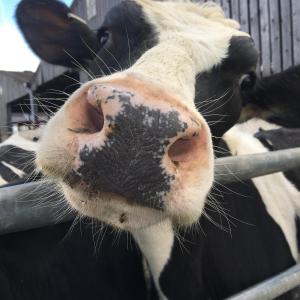
by Diane Watson

The abomasum, or "true stomach," is one of four compartments of the ruminant stomach and responsible for digesting food after fermentation in the rumen. A displaced abomasum (DA), also known as "twisted stomach," occurs when the abomasum shifts from its normal position, either to the left (LDA) or right (RDA) side of the abdomen, leading to digestive disturbances, reduced feed intake, and potentially severe metabolic consequences if untreated.
Causes of Displaced Abomasum
A displaced abomasum usually affects high-producing dairy cows, often within the first few weeks after calving. Several risk factors may contribute to the development of a DA including low dry matter intake, metabolic disorders such as ketosis and low blood calcium, sudden diet changes, twins or a large calf, excessive body condition loss and many others.
Symptoms and Diagnosis of Displaced Abomasum
Symptoms vary from mild to severe, depending on the degree of displacement and cow’s overall health. Common signs include reduced appetite, weight loss, decreased milk production,
dehydration, and altered manure consistency. RDA may cause more severe symptoms like colic, abdominal distension, and shock. Diagnosis is based on clinical signs, history, and physical
examination, including rectal palpation. Vets typically use auscultation of the abdomen to listen for the distinctive "ping" sound, which is caused by the abnormal gas buildup in the stomach. This combination of diagnostic techniques allows for an accurate diagnosis and guides the choice of treatment.
Correction of Displaced Abomasum
Correcting a displaced abomasum is critical to prevent further complications such as shock,
severe metabolic disturbances, or even death. Treatment options depend on the severity of the condition and whether the displacement is left or right sided.
1. Surgical Correction:
○ All surgical techniques can be performed with the cow standing, whilst under
sedation and with the use of local anaesthetic.
○ Right Sided Approach (LDA): This method involves accessing the cow's left
abdomen through an incision on the right flank. Once the abomasum is
manually repositioned, it is anchored to the body wall with sutures, which are
often attached to the omentum, a fatty membrane connected to the abomasum.
This procedure is highly effective and has a high success rate.
○ Left Sided Approach (LDA): The abomasum is accessed via an incision on the
left flan, repositioned and sutured directly to the body wall to prevent future
displacements.
○ Right Sided Approach (RDA): RDA is less common but more serious. If the
abomasum twists, it can cause blood flow disruptions, leading to tissue death.
The surgical approach involves an incision on the right flank, where the
abomasum is repositioned and rotated if necessary. The surgeon may also
remove accumulated gas to alleviate pressure. Once repositioned, the
abomasum is fixed to the body wall.
2. Laparoscopic Surgery:
○ Laparoscopic correction is a modern and minimally invasive technique. It
involves making two small incisions (~2cm) on the left flank to insert a
laparoscope (a thin, long camera) and surgical instruments.The surgeon
visualizes the abomasum, repositions it, and secures it with a toggle to prevent
future displacements. Laparoscopic surgery has the advantage of reduced
complications, faster recovery, less pain post-op and a reduced need for
antibiotics compared to traditional open surgery.
3. Post-Operative Care:
○ The cow should receive supportive care including pain management, fluids, and
monitoring for complications.
Conclusion
Displaced abomasum is a common and serious condition in dairy cattle that can significantly impact health and milk production. Early detection and treatment are crucial for a positive
outcome. With appropriate input from your vet and nutritionist the risk of DA can be minimised, ensuring the health and productivity of dairy herds.